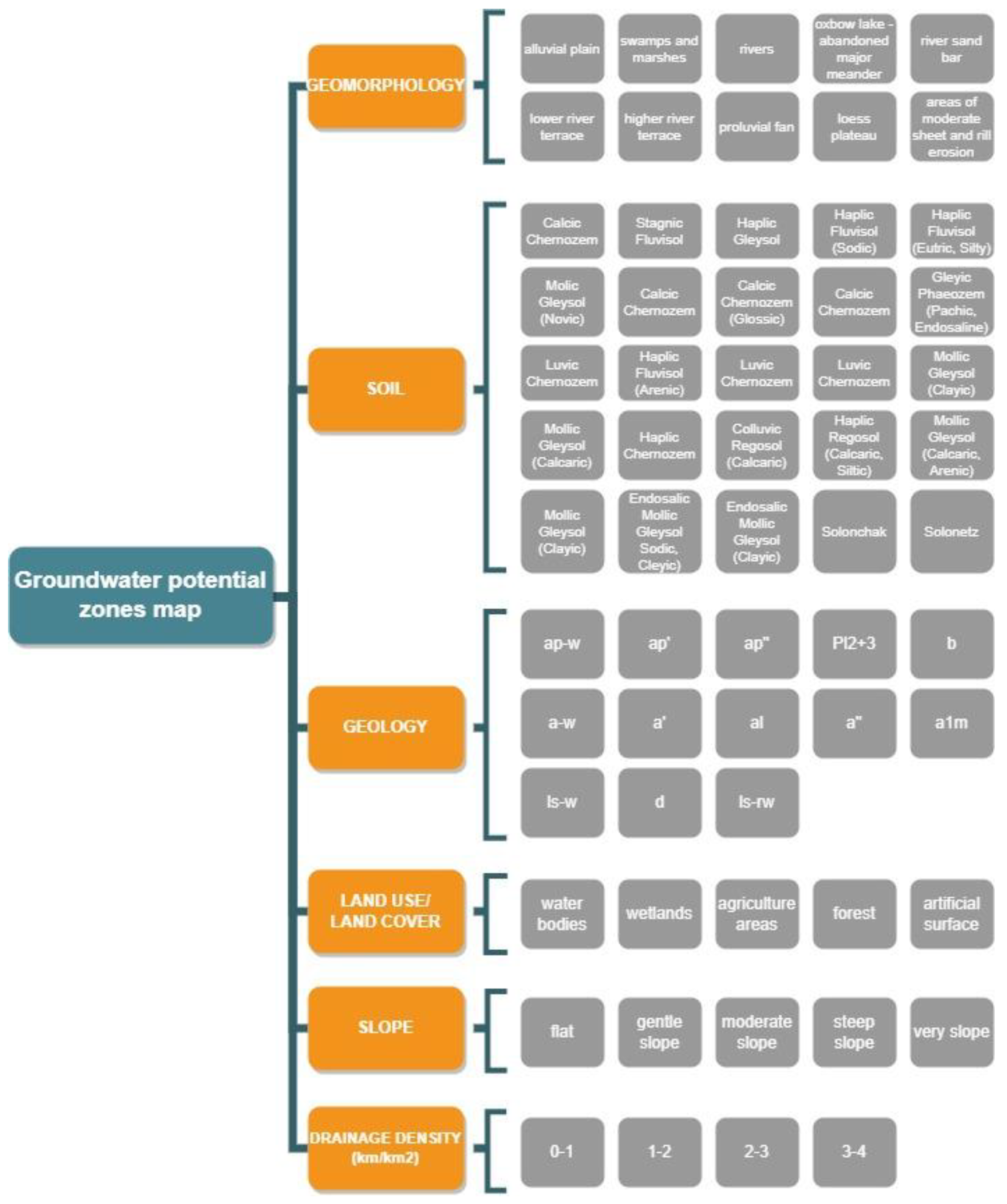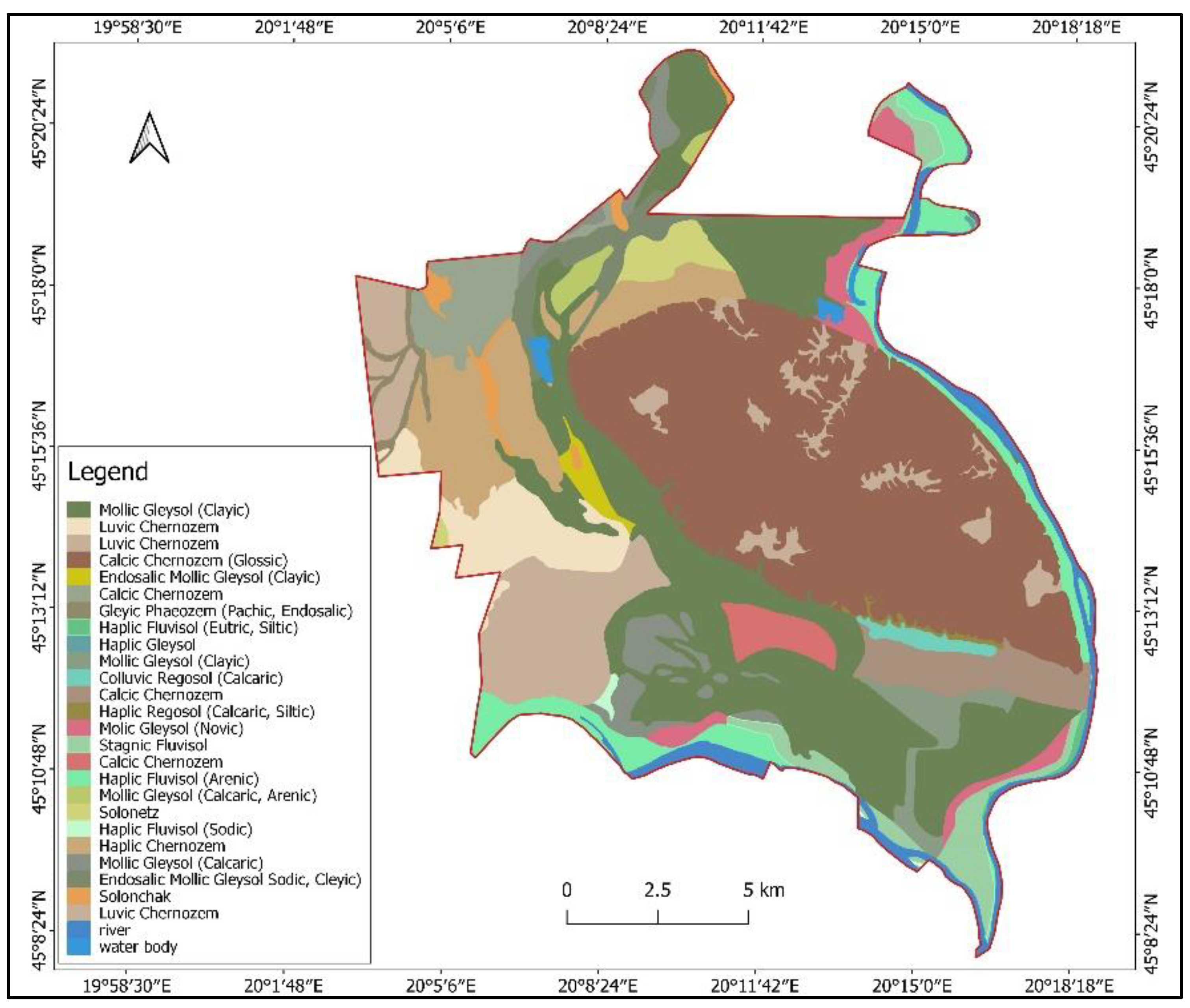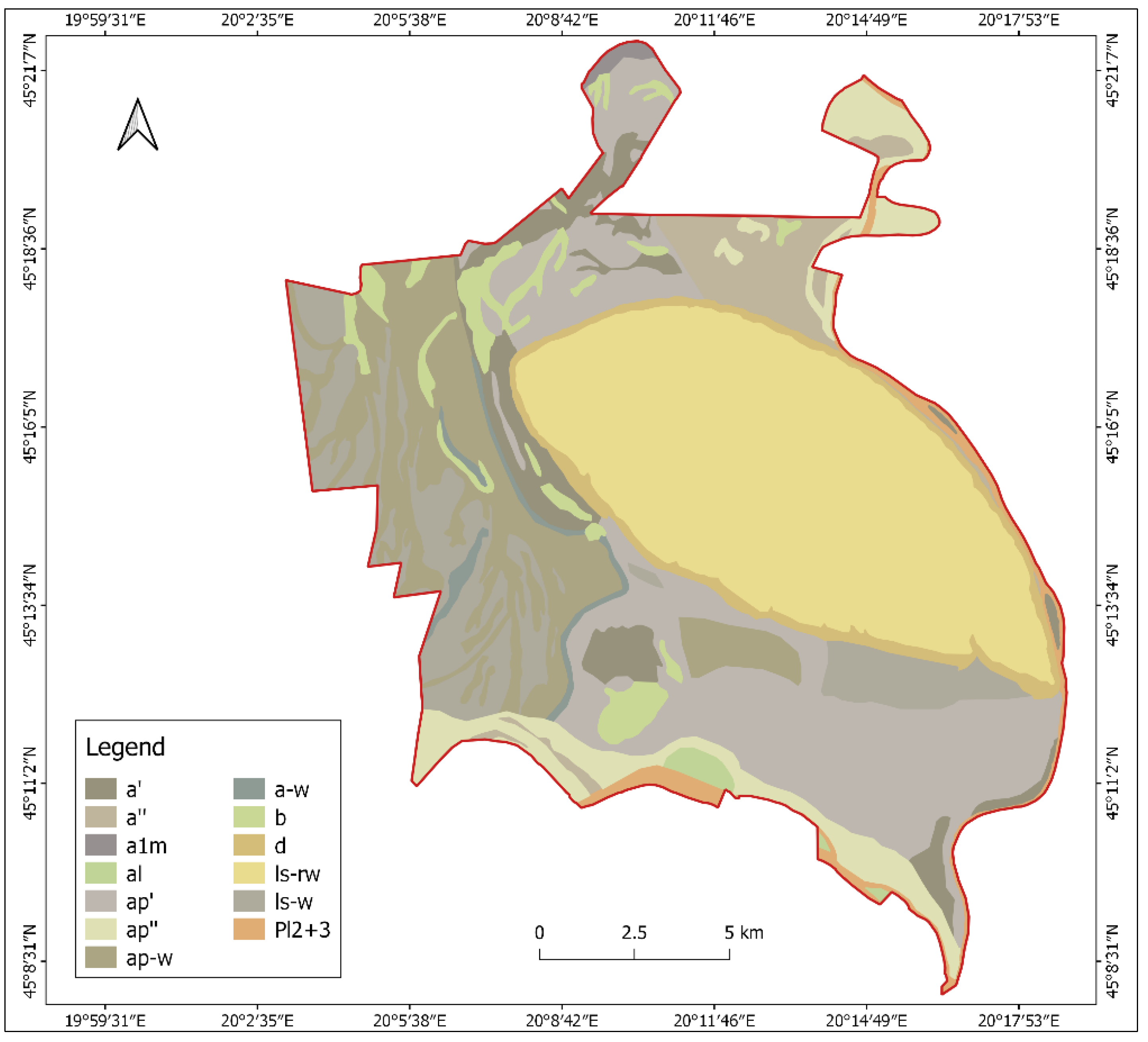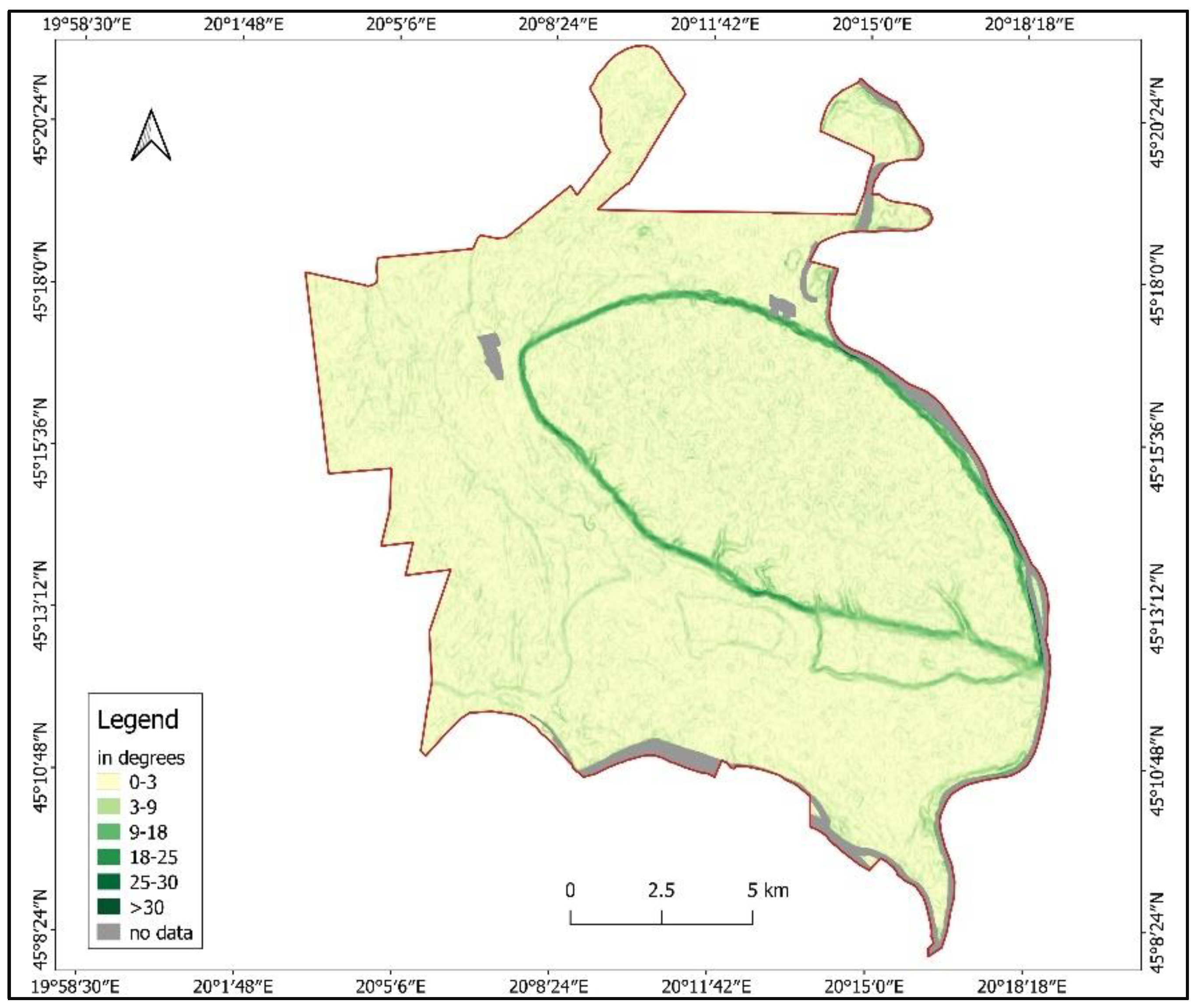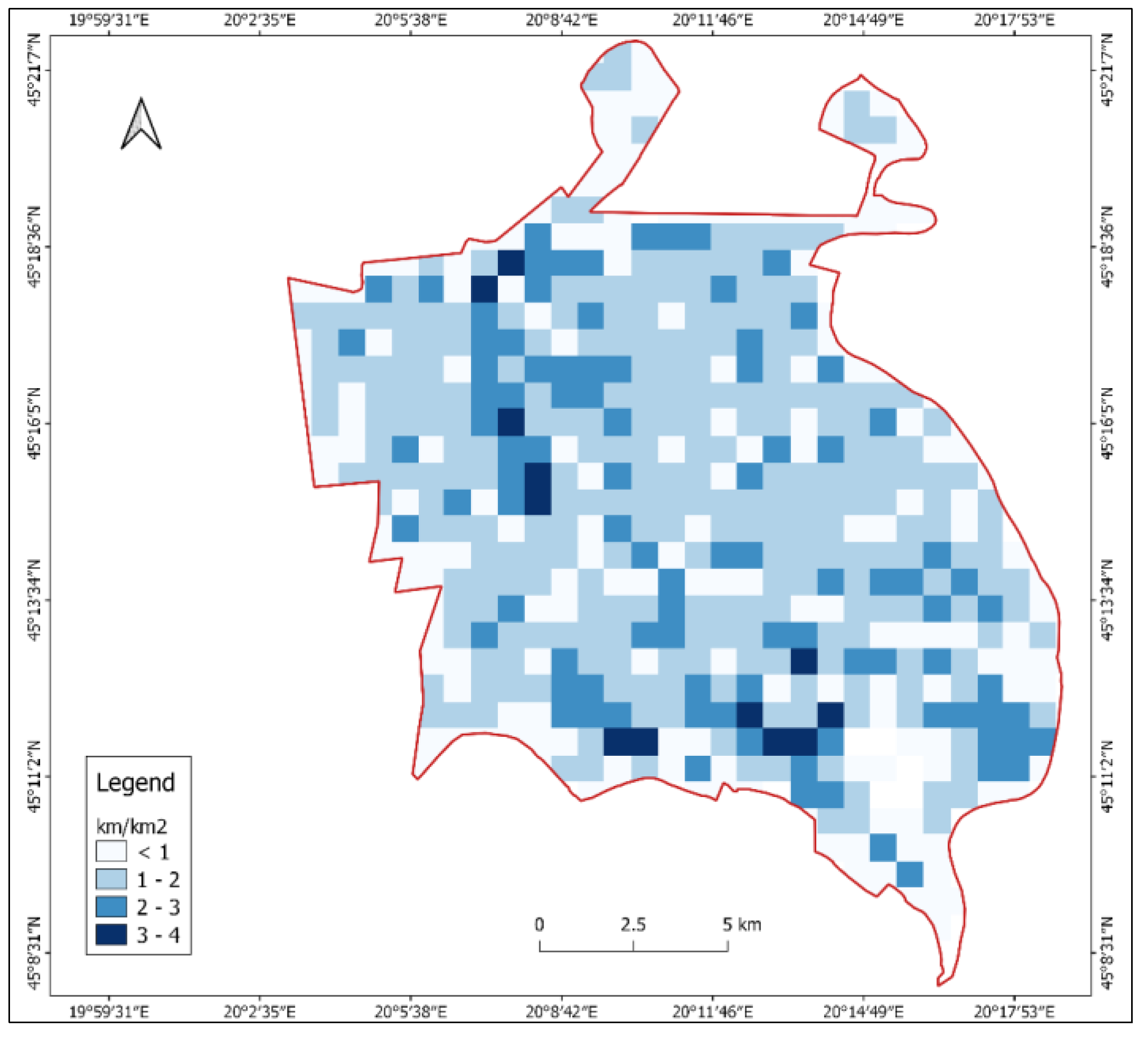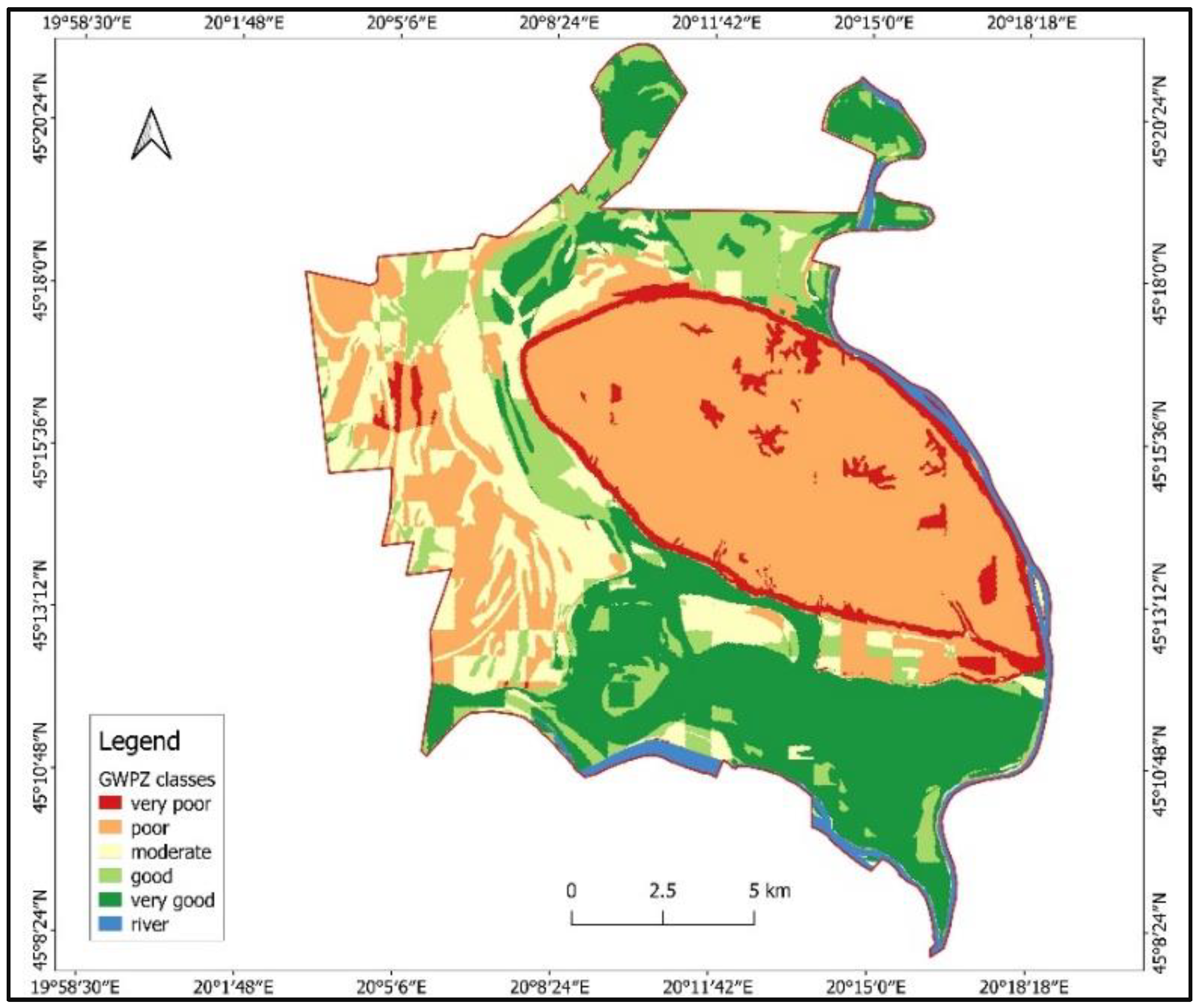1. Introduction
Groundwater represents one of the most important natural resources collected in the subsurface geological structures [
1]. It is the largest available freshwater resource on the earth, which primarily serves domestic purposes, industrial, and agricultural uses [
2,
3,
4]. According to FAO [
5], groundwater represents 26% of global renewable freshwater resources. Due to the drastic population growth but also the global impact of climate change, repetitive drought conditions, and lack of rainfall [
6], demand for groundwater resources has been drastically increasing in the past decades. In recent years, increasing agriculture production is putting pressure on groundwater resources for irrigation, especially in arid and semi-arid regions, which require an enormous amount of water supply and are usually used unsustainably. Further, it causes problems, such as decreased groundwater levels, water pollution from agriculture, and degradation of water quality [
7,
8]. To manage these problems, we have to know how much water exists underground and how much we can use for different purposes. Groundwater monitoring is very important when it comes to understanding the capacity and possibilities of existing reservoirs. Data can help us understand natural and artificial factors, which could affect groundwater level, quality, as well as consumption [
9,
10]. Based on new knowledge and research, governments could pay more attention to developing a sustainable groundwater management practice, and planning delineation of the groundwater potential zones is among the first steps for creating management strategies.
Groundwater in Vojvodina is one of the most important natural resources, especially in agriculture, presenting the main source for crop growth. Collected in the Neogene and Quaternary sediments, groundwater in Serbia is abundantly distributed, where 75% of the population is using these resources for a different purpose. Knowledge about groundwater regime and capacity is important for irrigation and land drainage. Despite this fact, research about the availability and useability of groundwater in Serbia is deficient and has not been sufficiently studied. According to the research of Jaroslav Černi Water Institute, only 30% of groundwater is used out of the total estimated of 67 m
3/s [
11]. However, unsustainable water exploitation from the principal aquifer consuming more than the rate of restoration caused a significant decrease in the piezometric level in some regions in Serbia [
11]. Based on that, it is very important to work on the identification of the potential location for new groundwater development. The aim is to improve the sustainable management of groundwater resources in Vojvodina region, the main agricultural region in Serbia, to conduct groundwater exploration faster and more efficiently.
With the advent of digital technology, including powerful computers and the possibility for integration of modern methods within a geographical information system (GIS) and remote sensing, it is possible to work on more complex and advanced hydrological research, such as delineation of groundwater potential zones (GWPZ), in any region [
12]. These advantages replaced traditional data collecting and enabled easier and cheaper access to data [
13]. Using GIS techniques, it is possible to operate huge databases, which are crucial for creating a good system for the decision-making process in different fields [
3,
14]. Researchers are now familiar with geospatial technology, which is necessary for generating spatial results, enabling more successful and easier processes for decision makers. Using factors that control the occurrence, origin, and movement of groundwater, such as geology, geomorphology, slope, soil, land use/land cover, drainage density, rainfall intensity, anthropogenic factors, etc., researchers can easily delineate the GWPZ [
8,
15,
16,
17,
18,
19].
Different methods have been used for the delineation of GWPZ and their mapping. Some of the research works used multi-criteria decision making (MCDM) [
17,
20,
21,
22], logistic regression [
23,
24,
25,
26], evidential belief function [
25,
27], artificial neural network model [
28], machine-learning techniques, such as random forest and maximum entropy [
29], and many others. Recently, a combination of MCDM and GIS techniques was found as most popular for resolving different complex decision-making problems in natural resources, including investigation of groundwater potential zones [
30,
31,
32,
33,
34,
35,
36,
37,
38]. Among several MCDM techniques, such as fuzzy set theory (FST) [
39,
40,
41], data envelopment analysis (DEA) [
42], TOPSIS [
43,
44], ELECTRE [
45], multi influencing factor (MIF) [
46], and PROMETHEE [
47], the analytic hierarchy process (AHP) is widely used and much more common for the groundwater potential zones delineation, especially because of the possibility for integration in GIS [
48,
49,
50,
51,
52]. This method was developed by Professor Thomas L. Saaty in 1977 and received most attention in natural resource management applications [
53]. It is based on generating the weight for each criterion according to the decision maker’s pairwise comparisons of the criteria. These weights are crisp numbers that do not include any uncertainty associated with weights. In order to overcome this problem, fuzzified AHP technique was applied in this study. This fuzzy AHP method was developed by VAN Laarhoven and Pedrycz in 1983 [
54] and uses fuzzy numbers instead of crisp numbers for solving multi-criteria decision problems. Since then, this method has been applied as solution for different decision-making problems [
39,
55,
56,
57,
58,
59,
60,
61].
Considering that, we used a combination of GIS and FAHP techniques to delineate GWPZ map examining the case of municipality where people are heavily dependent on groundwater resources for their domestic, agricultural, and industrial requirements. We examined the pilot work on the municipality to see if it is possible to apply this method for upscaling on the whole agriculture region (Vojvodina Province) where geomorphological, geological, and soil conditions are very similar. Considering that, if this methodology gives successful results on this pilot area, we will prove that it could be useful to also apply it to the wider area. Besides, we tried to show that even in cases where there are no available field measurement data, the whole process generating effective results for decision makers could be successfully performed using a small data set created by only collecting physical geographical data. For that purpose, six different decision criteria (geomorphology, geology, soil, slope, drainage density, and land use/land cover) relevant to groundwater storage were used for delineating the groundwater potential zones using FAHP as the most common multi-criteria method in water resource management.
3. Results and Discussion
In this section, we are going to present the results and discuss the various thematic maps and features, their weights assigned through FAHP, and the final GWPZ map.
3.1. Weight Normalization for Thematic Maps
In this research, the fuzzy AHP method was applied for potential groundwater zone delineation. This technique was used for assigning the weight to each theme and their features (
Table 5) according to expert opinion and knowledge. The highest weight was given to geomorphology, followed by soil, geology, land use/land cover, slope, and drainage density. Through several iterations, appropriate weights were assigned, and adequate consistency ratios were gained. Fuzzy weights were assigned to each raster file, and further analyses were conducted in QGIS environment.
3.2. Thematic Layer Analysis
3.2.1. Geomorphology
The geomorphology of an area is significant information used for the delineation of GWPZ, which controls the subsurface movement of groundwater [
78]. In this study, it has a weight of (W
i) 29.21%, ranked as the most important criterion for GWPZ delineation. Knowledge about geomorphology is crucial for the development and effective management of groundwater resources of an area [
16]. In the landscape of the Titel Municipality, we noticed about thirteen types of landforms. The main categories of landforms are the alluvial plain, which covers about 38% (98.60 km
2) of the area, then loess plateau (30%, 77.26 km
2), higher river terrace (15%, 38.91 km
2), and lower river terrace (11%, 28.35 km
2). Other forms have a much smaller area, and they are areas of moderate sheet and rill erosion (2.9%, 7.58 km
2), proluvial fan (0.78%, 2.03 km
2), swamps and marshes (0.27%, 0.71 km
2), river sand bar (0.12%, 0.31 river sand bar), and oxbow-lake-abandoned major meander (0.04%, 0.11 km
2). According to previous research, we recognized that alluvial plain, oxbow lake, river sand bar, and swamps and marshes have a big potential for groundwater storage. On the other hand, loess plateau with cracks provides a system for rapid water transmission to the deepest layers, so it has the smallest significance related to collecting, infiltrating, and occurring of groundwater. The geomorphological map is shown in
Figure 4.
3.2.2. Soil
Soil characteristics have a considerable role in the infiltration of water, and it occurs second with 26.35% (W
i). The rate of infiltration largely depends on the soil texture and related hydraulic characteristics of the soils [
13,
16]. According to World Reference Base for Soil Resources [
79], seven soil classes, such as Fluvisol, Chernozem, Regosol, Gleysol, Solonchak, Phaeozem, and Solonetz, are distributed across the study area (
Figure 5). They have a different variety according to their physical, water-physical, mechanical, and chemical properties (
Table 6).
Calcic Chernozem, Stagnic Fluvisol, Molic Gleysol (Novic), Haplic Gleysol, different varieties of Fluvisol, have a good water-holding capacity. This type of soil is distributed in the area of loess plateau, higher and lower river terrace, and in the alluvial plain. Soils such as Solonetz, Solonchak, different varieties of Regosol, and different varieties of Gleysol (except Molic Gleysol (Novic) and Haplic Gleysol) have poor water-holding capacity and were ranked significantly lower. These are mostly located in the lower parts of the study area with small distribution on lower and higher river terraces.
3.2.3. Geology
The weight (Wi) of geology classes is 21.18%, ranking third among the criteria selected for GWPZ mapping in this study area.
The geology of terrain plays a significant role in the occurrence and distribution of groundwater [
16,
78]. Some studies [
80,
81] take into account the geological factor because of its strong influence on water percolation, but some researchers, such as Edet et al. [
82], neglected this factor because they consider that information about lithology is provided by the lineaments and drainage characters. Quaternary sediments are dominant in the study area. The Pleistocene (ls—w, ap—w, a—w, ls—rw) and the Holocene (al, b, ap”, a, a’, a
1m, d) sediments occurring in the form of sandy clay aleurite, aleurite sandy, gravel, aleurite clay, brown clay, and loess are the most widespread. In the south of the study area, sediments of the middle-upper Pliocene (Pl
2+3) occur. Alluvium has the highest potential for groundwater storage, so all formations were ranked with highest rank (X
j). From the opposite side, lesoidal on the loess plateau was ranked with the lowest rank. The spatial distribution of major geological classes in the study area is shown in
Figure 6, while the area of each geology unit is presented in
Table 7.
3.2.4. Land Use/Land Cover
Land use/land cover ranks fourth, with 10.87% W
i, and it is an important factor for the development of groundwater resources [
83]. The nature of surface materials is necessary to help quantify the water budget because it has a significant influence on control runoff and infiltration [
7,
84]. Evapotranspiration, volume, and recharge of the groundwater are also affected by LULC [
2]. In the present work, standard visual interpretation methods show several classes that give the essential information on groundwater, soil moisture, infiltration, etc., in addition to providing an indication of groundwater requirements. The LULC map shows that by far the largest area in the municipality is occupied by agricultural land, about 82% (215.17 km
2), followed by forest areas (9%, 23.71 km
2), artificial surface (5%, 12.91 km
2), water bodies (3%, 7.17 km
2), and wetlands (1%, 1.86 km
2) (
Figure 7).
3.2.5. Slope
Slope takes place in fifth order, with 7.3% W
i. A slope is a change of elevation of a surface and the principal factor of the superficial water flow. Slope is a significant terrain characteristic and is directly proportional to the runoff and groundwater recharge. According to Fox et al. [
85], infiltration rate decreased until 11.5°, and with further increase of the slope, infiltration remained the same. Considering that, we categorized slope into three classes where slopes larger than 11° were categorized in one class. The three classes are: 0–5° (flat), 5–11° (moderately sloping), and 11–31° (steep sloping). According to
Table 8, flat terrain is the most widespread, with 95.81%, while very steeply sloping occupies only 0.04% of the territory. The slope map (in degrees) of the study area is presented in
Figure 8.
3.2.6. Drainage Density
In sixth place is drainage density, with weight of 5.08%. The drainage density (km/km
2) is an important component for the assessment of groundwater availability and runoff distribution. The drainage network depends on the lithology, and it provides an important index of infiltration rate. Because of that, it is an indispensable parameter when it comes to the identification of groundwater zones [
15,
17,
86]. In this paper, a drainage density map was extracted using the digital elevation model (DEM). The study area was divided into a grid (cell size 1 km
2), and the total length of drains was calculated per cell. The grid size (1 km
2) was considered appropriate according to the complexity of the terrain and the area of the municipality. Further, by dividing the total length of all drains in a drainage basin by the total area of the drainage basin [
87,
88], the map of drainage density was generated. This process was performed in GIS environment following Equation (10):
where
DD—drainage density;
Lws—total length of drains in the drainage basin;
Aws—area of the drainage basin.
Drainage density was reclassified and categorized as very low (<1 km/km
2) when occupying 31.79% (180.9 km
2), low (1–2 km/km
2) with 47.79% (271.92 km
2), moderate (2–3 km/km
2) with 17.6% (100.14 km
2), and very high (3–4 km/km
2) covering 2.82% (16.05 km
2).
Figure 9 depicts the drainage density map of the Titel Municipality.
3.2.7. Groundwater Potential Zone (GWPZ)
Groundwater is a very important renewable resource, but drastic population growth coupled with increasing need for water resources for food production, anthropogenic activities within agricultural production, industrial purposes, and domestic needs, all have a strong influence on discharging of groundwater reservoirs. A better understanding of the groundwater potential is of supreme importance for the planning and sustainable development of water management of an area. Such information is essential for the design and implementation of structures for corrective measures to improve groundwater recharge processes.
GWPZ map (
Figure 10) of the Titel Municipality was generated through the integration of six thematic maps. For each thematic layer, the weight was given according to its importance in groundwater occurrence, storage, and movement (
Table 3). This judgement by experts was formulated using the FAHP technique. By calculating the GWPI, we obtained values and classified them into five classes (
Table 9).
The Municipality of Titel has 25.68% (65.91 km2) of the area classified as very good. The whole alluvial plain and north part of the higher river terrace are classified as good and cover 12.10% (31.05 km2) of the study area. Subsequently, 15.18% (38.95 km2) is recognized as moderate, 41.34% (106.09 km2) as poor, and 5.7% (14.63 km2) as very poor, and this zone is identified at the loess plateau and in the artificial areas.
3.3. Discussion
Considering the previous research, most of the area in the municipality possesses good and very good groundwater zones (
Figure 10). These zones are recognized in the whole alluvial plain of the Danube and the Tisza River, occurring with 77% representation in good and 98% in very good potential areas. The main reason for this is the proximity to the rivers, which has a significant influence on groundwater recharging. Additionally, this is the lowest part of the terrain, which indicates that there is the main “collector” for all groundwater that flows from higher relief units. Besides that, 13% and 10% of the good potential area occur on the lower and higher river terrace, respectively. When it comes to the very poor zone, it is mostly located in the area of moderate sheet and rill erosion, with 46%. Very poor and poor zones are also recognized on the loess plateau, corresponding to 37% and 68% representation in these classes, while the moderate zone occurs on the lower river terrace, with 43%, and higher river terrace, with 36%. The low potential of loess plateau is a consequence of high runoff from this relief unit to the lower parts, as well as poor potential of water retention of lesoidal, which covers the loess plateau.
Infiltration and movement of the groundwater also depend on the soil type, permeability, and porosity. In the study area, several types of the Fluvisol, Gleysol, Chernozem, Regosol, etc., were recognized. As Glaysol is hydric soil, which is seasonal or permanently saturated by groundwater, approximately 70% of the very good and good potential areas of the GWPZ classes are covered by different type of this soil. Besides, 15% is covered by types of Fluvisol, which have good water-holding capacity. Haplic and Luvic Chernozem cover around 51% of the moderate potential zone, while areas of poor and very poor zones are covered approximately 63% by Calcic Chernozem. Even though Chernozem has a good water-holding capacity, the high representation in very poor and poor zones is caused by its location on the loess plateau, which is characterized with very low importance for groundwater occurrence but in the theme with the highest weight.
When it comes to the geology of an area, porosity and permeability of the geological units affect the amount of groundwater storage in sediments [
78]. Among the different geological formations in the study area, unconsolidated flood sediments, which spread over alluvial plains, cover around 70% of the very high groundwater potential area. From the opposite side, loess plateau is covered with lesoidal, which is not so permeable and, here, has the poorest potential for groundwater storage.
Land cover type could highly affect the rainwater runoff, intensity of infiltration, as well as intensity of evapotranspiration. It depends on different land cover classes. In this study area, five different land cover classes are recognized. Among them, water bodies and wetlands present a direct source of groundwater recharge [
89]. In this area, agriculture land is flat and porous, where runoff is negligible, but infiltration is high, which is a great condition for containing groundwater. The agriculture area is predominantly located in the municipality and largely overlaps with very high (79%) and high (77%) groundwater potential zones. The lowest potential for containing groundwater is presented by the artificial surface, which could affect surface water runoff, reducing the infiltration from surface to underground.
Surface runoff depends on the degree of slope, which is essential for groundwater recharge. If slopes are larger, then the infiltration will be smaller because the water received from precipitation flows rapidly down a steep slope, and it does not have sufficient residence time to infiltrate to the saturated zone. Otherwise, if it is smaller than the infiltration and recharge, the saturated zone will be larger [
12,
17,
90]. In this study, very good groundwater potential zone is completely below the flat area, while 75% of the good potential zones have a moderate steep slope. Poor potential is recognized in the area of moderate slope (56%) and in the area of steep slope (42%).
The movement and infiltration also depend on the drainage density of some areas [
86]. A higher drainage density tends to indicate lower groundwater potential. Low drainage density represents high infiltration and hence contributes more to the groundwater potential. In this study area, 80% of the good and very good groundwater potential area is discovered in the area with low and moderate drainage density.
Generating the results based on systematic, internally consistent, and quantitative evaluation of expert knowledge obtained by the Saaty’s scale and extended FAHP multi-criteria analysis, the map of GWPZ was produced for the Municipality of Titel. This pilot project showed that, with this type and amount of data, it is possible to delineate the GWPZ for the area with similar circumstances and where reliable data about groundwater are missing. Nonetheless, this research suffered from the absence of data about groundwater level, as well as meteorological data (precipitation, solar radiation, air temperature). Due to this, we also could not calculate evapotranspiration on high spatial resolution. Further, the hydrodynamic behavior was not also considered in depth, which is another possibility to consider during work on such research. Nevertheless, these six criteria chosen in this study are suitable for the delineation of the GWPZ in moderately continental climate areas. The other climate conditions would require further analysis.
However, even if this methodology is good for solving complex decision-making problems, there are some limitations. Firstly, finding experts in relevant fields for pairwise comparison can be difficult and could be seen as a limitation. Additionally, the number of criteria may be considered a limitation, i.e., the more the number of criteria increases, the more difficult it is to solve a pairwise matrix. In this case, experts need a lot of effort and time to spend on working, and if consistency is not satisfied, the experts have to re-assign the weight [
91]. However, no matter which analytical decision tool is chosen, the implementation is complex. In research like this, with limited data, this approach could be used as the most suitable tool for solving different groundwater management problems.
4. Conclusions
The present study focused on a probabilistic approach that used a combination of GIS and fuzzy AHP techniques to find the potential groundwater zones in the small Municipality of Titel. Using extended fuzzy AHP methods and expert opinion, a more detailed, systematic, and complex assessment of natural conditions was carried out. A total of six thematic layers, such as geology, geomorphology, LULC, drainage density, soil, and slope, were used to delineate the GWPZ. These thematic maps are integrated and overlaid in QGIS software. Based on it, the GWPZ in the Municipality of Titel were delineated and classified into five classes as very good (25.68%), good (12.10%), moderate (15.18%), poor (41.34%), and very poor (5.7%). These techniques indicated that very good and good groundwater potential zones are predominantly located in the alluvial plains of the Danube and Tisa Rivers, covered with unconsolidated flood sediments. This is also a flat agricultural area with low drainage density, which are good conditions for groundwater storage. Otherwise, very poor and poor potential zones are located in the central part of the study area, on the landform of the loess plateau and in the artificial areas. Combining FAHP and GIS techniques, we found that even with a small and limited data set, this approach could be used for delineation of GWPZ and upscaling on larger region with the same natural and socio—economic settings. It is confirmed that FAHP presents a good method for complex decision—making problems in the field of groundwater management, generating useful results for decision makers. This is especially important for countries and regions, which abound in groundwater but have poor data and aspire to develop sustainable groundwater management, as in the case of the Vojvodina region. Since most of the area of the municipality is covered by agricultural land, this study will help improve the irrigation facility and develop the agriculture productivity of the area by enhancing groundwater management.


